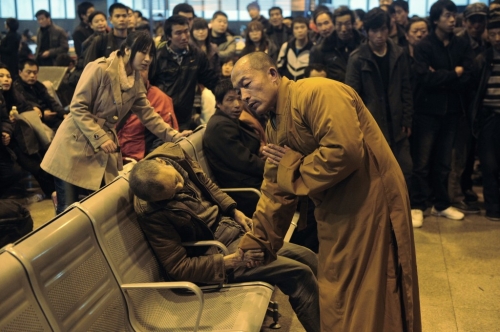Our first Buddha Buzz item this week was brought to my attention by a Tweet from the blogger behind American Buddhist Perspective, Justin Whitaker. It’s about a photo that recently struck a chord with China and the world, of an anonymous monk praying over the dead body of a man in a Chinese train station:

The article that Whitaker Tweeted, available here, contrasts this photo with the video that went viral a few months ago that showed the plight of a young Chinese girl, Yue-yue. As Yue-yue was run over not once, but twice, eighteen people walked or drove by her without stopping to help or moving her out of harm’s way. It wasn’t until the nineteenth person passed by that anyone came to her aid. Yue-yue was brought to a hospital but died a week later.
In the aftermath of the video, public opinion, both within China and internationally, came down hard. How could eighteen people walk by a two-year-old girl bleeding on the street and not do anything to help?
And now, there’s this beautiful photo. The article’s author says it better than I can:
The praying monk at the train station, in other words, came along at a moment with Chinese society is both disillusioned and yearning for something positive. He exemplified a return to humanity and basic compassion.
He symbolizes an ideal version of what a monk, or a man should be. He gives me a sense of warmth,” says Liu Xiaocun, an editor based in Beijing.
As for the man who has inspired this warmth, no one has a clue as to who he is and where he is now.
That too is fitting. Traditionally, a monk is not allowed to shelter under any one tree for more than three days. He is supposed to wander so as to avoid worldly attachments.
The one thing that is sure is that–wherever he is–he will keep on praying.
Elsewhere in the Buddhist world, a less religious chord is being struck: Jon Kabat-Zinn’s Mindfulness-Based Stress Reduction technique has made it all the way to Time magazine. It’s an interesting interview, but the rhetoric that Time uses all over the article gave me a good laugh. The tagline, for instance: “Meditation isn’t just for hippies anymore. And it’s not all about saying ommmm.” Thanks, Time.
Here’s an excerpt of the interview, which is considerably better than the tagline:
My working definition of mindfulness is the awareness that arises through paying attention on purpose in the present moment — non-judgmentally. And the non-judgmental part is the kicker, because we’ve got ideas and opinions about virtually everything. Our consciousness is almost always colored by our likes and dislikes. All highly conditioned, habitual behaviors really comes down to this: do I like it or not, do I want more or do I want to escape? That’s all going on below the surface of awareness and it runs our lives.
What would be an example of that?
Do you have a smartphone? The impulse to check it can come up in the strangest of moments and you can become aware of how strongly you actually want to distract yourself from the present moment. There might be an important email waiting for you, or something to take you away from this crappy boring moment. Even before smart phones and the internet, we had many ways to distract our selves. Now that’s compounded by a factor of trillions.
When you have children, you realize how easy it is to not see them fully, and perhaps miss all those early years. If you are not careful, you can be too absorbed in work and they will be only too happy to tell you about it later. Being a parent is one of greatest mindfulness practices of all.
Mindfulness isn’t about getting your way or meditating so that you can be better at something. My definition of healing is coming to terms with things as they are, so that you can do whatever you can to optimize your potential, whether you are living with chronic pain or having a baby. You can’t control the universe, so mindfulness is involves learning to cultivate wisdom and equanimity— not passive resignation—in the face of what Zorba the Greek called the full catastrophe of the human condition.
And since Buddha Buzz the past few weeks has been a bit heavy, I wanted to leave you with a link to a dance troupe who just started their 2012 world tour: Shen Yun Performing Arts. Shen Yun performs Chinese dance, with the aim of restoring and reviving traditional Chinese culture. They’ve been getting rave reviews and the website hosts some fun preview videos, so go ahead and check them out.
Got an idea for Buddha Buzz? Let me know on Twitter: @tricyclevarv
Thank you for subscribing to Tricycle! As a nonprofit, we depend on readers like you to keep Buddhist teachings and practices widely available.